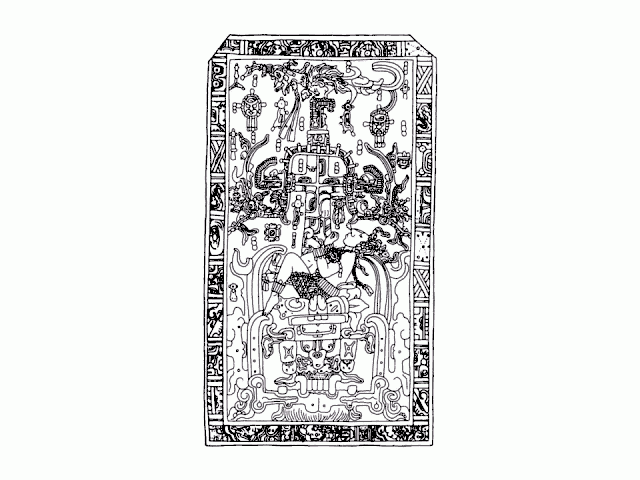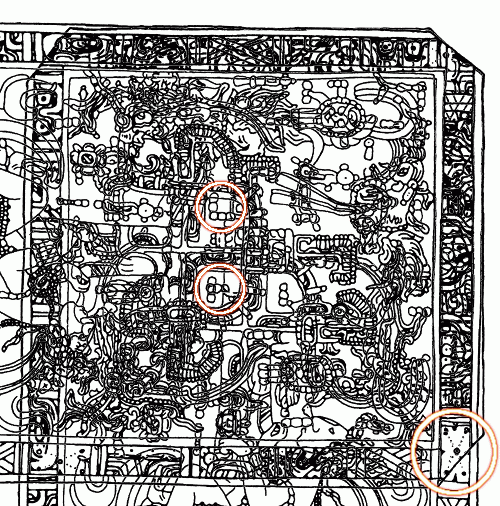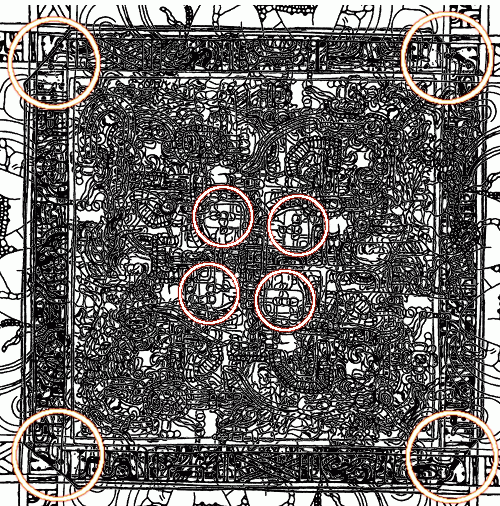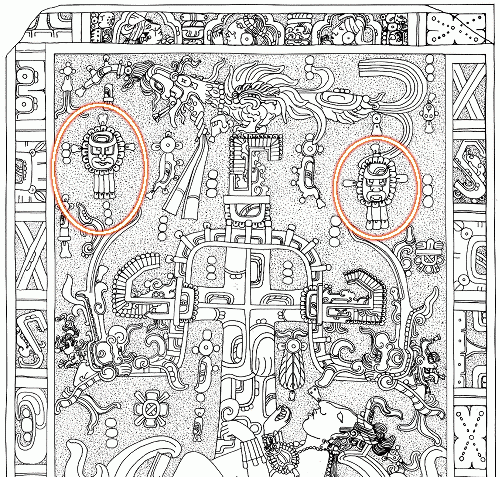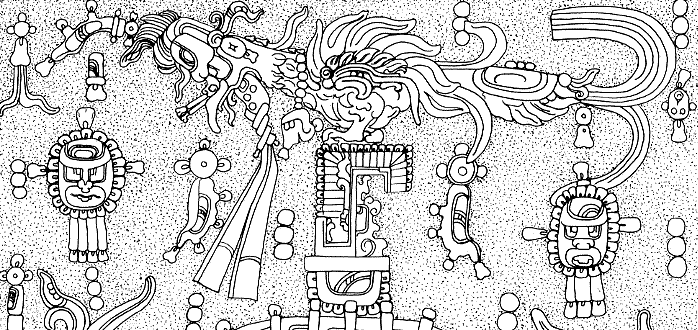The story begins some time in 1998, when I started to read a book by Maurice Cotterell and Adrian Gilbert, titled The Mayan Prophecies (in Hungarian: Maja próféciák). In this book Cotterell presented (among many other things) his theory about the Palenque sarcophagus lid containing hidden messages in its pattern that could be revealed by duplicating the picture and layering it over itself (as it is demonstrated for example in this animation).
I was really intrigued by the hypothesis, and decided to get to the bottom of it. In order to be able to reveal those mysterious hidden messages myself, I scanned the lid picture from the book and printed it on overhead transparencies we had in the office. But after spending many hours trying to reproduce the various overlay configurations presented in the book, I was a bit (or rather very) disappointed, as I could not recognize anything similar to the colorful figures of the book's illustrations.
I was just about to throw the slides away (together with the book), as I suddenly noticed the two X shapes on the edge, and (almost instinctively) put two pictures over each other in a way that the X shapes got connected to each other (just like we did it in step 2):
I was surprised to see how nicely the two layers covered each other, and also observed that those peculiar three-circled "things" inside started to join in some way:
As I happened to have printed 4 slides previously, I placed the remaining two on top of the stack, and was really happy to discover that all the X shapes were joined now, moreover the "things" inside connected to each other in a very promising way:
By now I was pretty sure: if the pattern of the lid really did contain a hidden message, then we should look for it inside the upper square, and those three-circled "things" would certainly play an eminent role in this code. But I did not have any idea, how to continue the process, so I put the slides into a dossier, the dossier into a drawer, and then forgot the matter almost completely.
It was another book, this time by Erich von Däniken, that some months later drew my attention to the lid again. In this book Däniken argued that the human figure depicted on the lid would represent an "ancient astronaut", as his pose and equipment would resemble that of a rocket pilot. This led me to take the slides out again, and I started to examine the picture more carefully, especially the upper square (as I was quite certain that this is the really important part of the pattern), and it was this time that I have actually noticed the two face-like shapes on it:
Observing the left one, a thought suddenly struck me: this figure could represent the Solar System with its 4 inner planets, with the Earth marked by a triplet, with the 6 visible planets and the 9 planets altogether (at that time the Pluto was still considered a planet):
And, of course, it seemed quite logical to discover another system in the shape on the right side, and in the bird at the top a symbol of a travel from that other system to the Earth:
I was also fairly sure that the triplets should encode the location of the other system somehow, but could not find a way to "break" the code. So I put the dossier with the slides into the drawer again, and forgot about the whole thing for a long time.
Then came the year 2001, which turned out to be a fateful one (unfortunately mainly in a negative sense) in my life. It was the last semester at the university I attended (Corvinus University of Budapest), and it seemed virtually inevitable that I would successfully graduate in June. But, regrettably, I met a girl there in early March, and went literally crazy trying to impress her, which eventually brought the sarcophagus lid to my mind again. The idea was: if I solved the code, I would certainly become famous, and then she would surely respect or even admire me!
So, on the last Friday before the Easter vacation (April 6) I decided that I will use this one-week rest for solving the code at last. On Saturday I wrote a small (very basic) utility to visualize the items in a coordinate system and to perform rotational operations on them. On Sunday morning I constructed with the help of it the initial layout (step 4), then executed the three rotations (step 5) and also the reflection (step 6), which I was already thinking about some weeks before as the next possible step. Then I modified the initial layout repeatedly (luckily only 3 or 4 iterations were needed), until a perfectly symmetrical control phase state was achieved (step 7). After taking a quick lunch, I printed out the state, and then watching the paper and concentrating on it for about an hour I have found a possible way to continue the process: we should connect the inner and the outer items to each other, and then move them toward the center. Of course, the utility did not have yet such a function integrated, so on Sunday afternoon and on Monday (April 9) I was busy making it a bit smarter by enabling it to handle different layers and move them separately. On Monday evening I could finally test the idea, and performed the moving step with very satisfying results (step 8). Finding the two folding steps was almost trivial by now, but of course I had to extend the functionality of the utility again to be able to perform these operations too. On Wednesday I was ready with the programming at last, and could execute the two folding steps (step 9 and step 10), but I had no idea, how to interpret the figure I got as a final result. Then that night I dreamed about some scissor opening and closing, and woken up I knew immediately that this could be the final operation in the solution (step 11). And so, on Thursday (April 12), the code seemed to be solved eventually, and I felt a great (almost euphoric) happiness because of this success!
But solving the code turned out to be the easy part of the task. I had to publicize the solution quickly somehow, in order to become famous and win her over before the end of the semester. (Did I already mention something about going crazy in those days?) I was working on an article until Easter Monday (April 16), and on Tuesday I sent it to a popular Hungarian scientific journal (Természet Világa). Unfortunately, this move proved to be a foolish one, as I wasted two or three valuable weeks waiting for some response from that journal, which of course never arrived. After this failure I had put a web page together including the study and some pictures, uploaded it to the Internet and then sent its link to other Hungarian scientific papers, but with the same result (i.e. got no response at all).
I was really stuck now, and the topic obviously seemed too complex and abstract even for the scientific world in the form as I tried to publicize it at first. So I decided to create animations in order to make the solution easier to follow and more understandable to the public. I found an ancient Autodesk Animator Pro for DOS on an old CD, and with the help of it I created on a Sunday (May 20) these two animations, which (should have) demonstrated the solution in an easily comprehensible way (#1, #2):
Note: the original AVI files had a somewhat better quality (and of course a much larger size too). As it is noticeable, the Kruger 60 system was determined as the final solution in this animation, but this only had the purpose of giving some definite answer to the initial question (and e.g. the SCR 1845-6357 system was not even discovered yet).
I uploaded these files to the web page, together with a shorter text, but the technical situation was far from ideal (as you may remember, we are in 2001). The files were huge (13MB and 27MB), and since they were not streamable (I used the AVI format instead of MPEG for a reason I really could not explain now, but it was obviously another bad decision), one had to download them completely, possibly through a 32k modem, before the playback even could have started.
Nevertheless I was really confident about the success now, and in addition to promoting the site to even more media, I started a topic on a Hungarian forum, and sent an email to the Ancient Astronauts Society with an English version of the text and links to the animations. And finally I got some responses! Although these were almost exclusively negative, but some responses at last! Ulrich Dopatka from the AAS wrote (not literally) that the animations were too slow to play back and too large to download (which was absolutely true), and that he thinks: actually solving an ancient code would require a much stronger effort and much more patience as I apparently possess (about this I'm not so sure, since solving a difficult problem is often only a matter of having a single good idea). Also the members of the forum complained about the large AVI files, and they also found it hardly imaginable that an ancient Mayan drawing would contain any reference to an interstellar travel, and that even if it did, an amateur (especially a Hungarian) could actually be able to crack such a coding system.
Meanwhile I started to run out of time, as the final exams for the degree were already round the corner. But instead of studying and attending the courses, I struggled further to publicize the solution somehow, eventually with a disastrous outcome: I could not convince anybody about the correctness of the solution, at the end of the semester I dropped out of the university, and the girl I wanted to impress moved to France without taking virtually any notice of my achievements. Ouch.
There was no use pressing the issue further, so I removed the page from the Internet completely, and tried to forget about the whole matter. In 2005 I took again a (short-lived) attempt to publish the solution, but nobody was really interested in it (including me), and so I deleted the site after only a few weeks. For this page I have also created an Allegro-based interactive visualizing utility, but it was rather cumbersome to download and run it. In 2011, when I started developing Java applications (after years of coding in C, C++ and C#), it seemed a good practice to create a Java applet version of this utility, which indeed succeeded fairly well. Then (especially after the applet technology died) I programmed also various standalone applications around this theme, and eventually had to ask myself, whether it would not be worth trying to publicize the solution once again, this time in English and using embedded GIF-animations for the demonstrations.
And so, in 2015, this document was finally created and then uploaded to GitHub.
